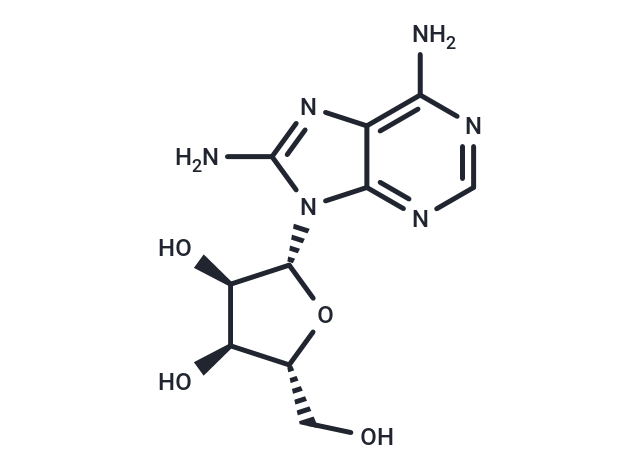- 全部删除
 您的购物车当前为空
您的购物车当前为空
购物车
8-Aminoadenosine
产品编号 T40483Cas号 3868-33-5
别名 8-氨基腺苷, 8-NH2-Ado
8-Aminoadenosine (8-NH2-Ado) is an RNA-directed nucleoside analogue that effectively diminishes cellular ATP levels and impedes mRNA synthesis. Furthermore, it effectively obstructs Akt/mTOR signaling, inducing autophagy and apoptosis in a p53-independent manner. Its significant antitumor activity further highlights its therapeutic potential.

8-Aminoadenosine
产品编号 T40483 别名 8-氨基腺苷, 8-NH2-AdoCas号 3868-33-5
8-Aminoadenosine (8-NH2-Ado) is an RNA-directed nucleoside analogue that effectively diminishes cellular ATP levels and impedes mRNA synthesis. Furthermore, it effectively obstructs Akt/mTOR signaling, inducing autophagy and apoptosis in a p53-independent manner. Its significant antitumor activity further highlights its therapeutic potential.
| 规格 | 价格 | 库存 | 数量 |
|---|---|---|---|
| 2 mg | ¥ 654 | 5日内发货 |
大包装 & 定制
加入购物车
TargetMol 的所有产品仅用作科学研究或药证申报,不能被用于人体,我们不向个人提供产品和服务。请您遵守承诺用途,不得违反法律法规规定用于任何其他用途。
联系我们获取更多批次信息
资源下载
产品介绍
生物活性
化学信息
| 产品描述 | 8-Aminoadenosine (8-NH2-Ado) is an RNA-directed nucleoside analogue that effectively diminishes cellular ATP levels and impedes mRNA synthesis. Furthermore, it effectively obstructs Akt/mTOR signaling, inducing autophagy and apoptosis in a p53-independent manner. Its significant antitumor activity further highlights its therapeutic potential. |
| 体外活性 | 8-Aminoadenosine (8-NH2-Ado; 0.1-10 μM; for 48 h) has IC50s of 1.5 μM and 8.88 μM in MM.1S and U266 cells, respectively[1]. 8-Aminoadenosine (10 μM; for 24 h) induces significant apoptotic death of MCF-7 cells in p53-independent pathway. 8-Aminoadenosine causes PARP cleavage in MCF-7 cells[2]. 8-Aminoadenosine (3 μM; 0.5-4 h) induces autophagy in the MM.1S cell line[1]. 8-Aminoadenosine (3 μM; 2-16 h) causes a greater drop in ATP levels in the MM.1S cells[1]. 8-Aminoadenosine (3 μM; 5 h) causes a 50% reduction in glucose consumption in MM.1S cells[1]. 8-Aminoadenosine (3 μM; 5 h) indicates a time-dependent decrease in GLUT1 expression at 5 h, whereas at 24 h there was a down-regulation of both transporters (GLUT1 and GLUT4) in MM.1S cells[1]. 8-Aminoadenosine inhibits cell proliferation, activated cell death, and does not activate transcription of the p53 target gene p21 or increase protein levels of either p53 or p21[1]. The toxic effects of 8-Aminoadenosine require adenosine kinase activity to convert 8-Aminoadenosine to 8-NH2-ATP in adenosine kinase-deficient cells[1]. Cell Viability Assay[1]Cell Line: MM.1S and U266 cells Concentration: 0.1, 0.3, 1, 3, 10 μM Incubation Time: For 48 hours Result: Had IC 50 s of 1.5 μM and 8.88 μM in MM.1S and U266 cells, respectively. Apoptosis Analysis[2]Cell Line: MCF-7 cells Concentration: 10 μM Incubation Time: For 24 hours Result: Induced significant apoptotic death. Apoptosis was not inhibited by knockdown of functional p53. Apoptosis Analysis[1]Cell Line: MM.1S cell line Concentration: 3 μM Incubation Time: 0.5, 1, 1.5, 2, 2.5, 3, 3.5, 4 hours Result: Induced the formation of LC3-II protein. Caused the appearance of a population with a high AVO content with 1 μM for 24 hours. |
| 别名 | 8-氨基腺苷, 8-NH2-Ado |
| 分子量 | 282.26 |
| 分子式 | C10H14N6O4 |
| CAS No. | 3868-33-5 |
储存&溶解度
| 存储 | Powder: -20°C for 3 years | In solvent: -80°C for 1 year | Shipping with blue ice. |
SCI 文献
计算器
体内实验配液计算器
请在以下方框中输入您的动物实验信息后点击计算,可以得到母液配置方法和体内配方的制备方法:
剂量转换
对于不同动物的给药剂量换算,您也可以参考 更多
评论列表
Related Tags: buy 8-Aminoadenosine | purchase 8-Aminoadenosine | 8-Aminoadenosine cost | order 8-Aminoadenosine | 8-Aminoadenosine chemical structure | 8-Aminoadenosine in vitro | 8-Aminoadenosine formula | 8-Aminoadenosine molecular weight





 还可以
还可以

评论内容